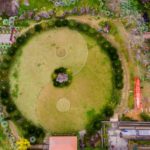The History of Feng Shui
Feng Shui is the art of placing and situating a structure so it is in harmony with nature. Also known as “Kanyu”, cultural and social issues are influenced by cosmological, metaphysical, and natural factors.
To use this ancient technique, you have to understand the influence of cosmology on earth. You should also have knowledge of how astronomy and astrology influence the placement of buildings. You also need to understand Confucian classics, the weathering process, the forces of nature, the magnetic fields, and how these all influence us. If you think about it, that is a lot to study.
West Han Dynasty
The history of Feng Shui originated in the West Han dynasty around the third century BC. Those who practice it believe that the earth is alive with energy. If people built a structure on land that has revitalizing energy, then they would prosper. If this is placed in a site with bad energy, misfortune will occur.
Originally, Feng Shui was used to help place tombs for those who have died rather than for building homes for a living. Back then, they believed that choosing a good burial site will bring peace and prosperity to those who remained here on earth.
The instrument used to select the correct burial site was known as the “Lo Pan.” This invention was traced back to the Yellow Emperor where it is said that the “Lady of the Nine Heavens” gave him this knowledge.
This ancient compass was called the Hin Shi and is described as a square base called a diviner’s board, holding a bowl of water that floated a magnetic south-pointing spoon. The Hin Shi then developed into the “Lo Pan” and during the Sang Dynasty, this was used to navigate at sea. When this was brought to Europe somewhere during the 13th Century, this was better known as the compass which helped navigators explore the rest of the world.
But going back to Feng Shui, if the “Lo Pan” can be used to pick good burial sites, couldn’t it do the same for erecting buildings where people could live? The answer is yes and so this device was now used to analyze the orientations in relationship to the main door, the bed, and the stove.
Since then, both the rich and the poor incorporate this into their architecture. Archeological studies have shown that ancient Chinese city planners were made in concentric rectangles surrounded by walls that were then surrounded by lakes, hills, valleys, gardens, courtyards, and parks which were to enhance positive energy.
As for buildings, these were constructed to enhance a healthy relationship between family members and the country.
This is where Yin and Yang come in which is considered to be the foundation of the universe. Coming from Taoism, these two are complete opposites that cannot exist without the other.
For them, the left side of the building must represent Yang or the male force while Yin or the female force is on the right.
Examples of Yang in the past included sunlit roofs, built areas, and an elevation in the front. For Yin, there must be empty areas, shadowed eaves, set-back structures, and elevations in the back.
The history of Feng Shui was almost forgotten when the communists took over in 1949. If it wasn’t for the masters who practiced it and shipped it out to Hong Kong or China, we would have never known it existed. Feng Shui made its way to the US only in the 1970s. Various articles and shows have focused on it and people now use it to help in building a house or a building.
DISCLAIMER:
This information is not presented by a medical practitioner and is for educational and informational purposes only. The content is not intended to be a substitute for professional medical advice, diagnosis, or treatment. Always seek the advice of your physician or other qualified healthcare providers with any questions you may have regarding a medical condition. Never disregard professional medical advice or delay in seeking it because of something you have read.
Since natural and/or dietary supplements are not FDA-approved they must be accompanied by a two-part disclaimer on the product label: that the statement has not been evaluated by FDA and that the product is not intended to “diagnose, treat, cure or prevent any disease.”





